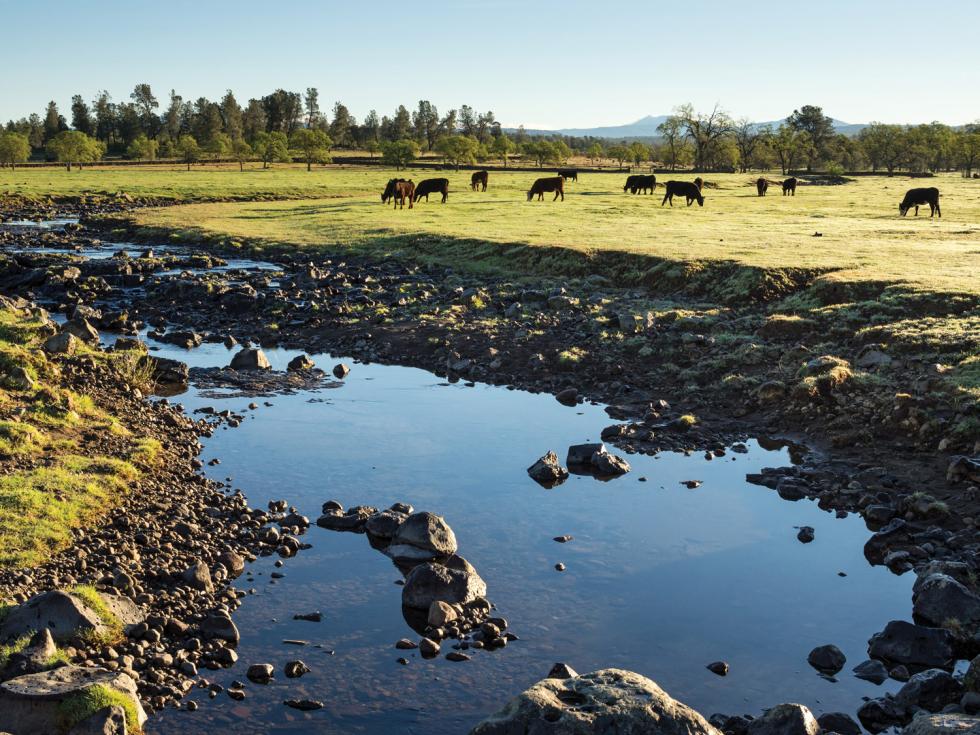Restaurateur Patrick Mulvaney says he thinks of himself and the farmers that he buys from as “careful stewards of the land.” Mulvaney primarily buys certified organic or sustainably grown farm products, and seafood approved by the Monterey Bay Aquarium’s Seafood Watch program. Servers at his Midtown restaurant, Mulvaney’s B&L, even limit pours of drinking water to patrons who specifically ask for it — a nod toward California’s ongoing drought.
But Mulvaney isn’t giving up his meat. Even though the rearing of livestock has considerable environmental impacts on water quality, land, wildlife and the climate, Mulvaney is not convinced by calls from a few activist groups and researchers to eat less meat. Instead, he chooses to support mostly growers of grass-fed, pastured meat rather than turn vegetarian.
“As a human, I’m an omnivore, and my kneejerk reaction to people saying we should eat less meat is to say that we should eat more sustainably raised meat,” he says.
Mulvaney is hardly alone in his stance. Most Americans are omnivores. Just 3 percent of people surveyed recently by The Vegetarian Resource Group claim to eat no meat at all, and the U.S. has a higher per capita rate of meat consumption than nearly any other nation — about 200 pounds each year, according to data from the Organisation for Co-operation and Economic Development, an intergovernmental group based in Paris.
According to some ecologists and experts on global agricultural trends, our eating habits must change dramatically if we are to overcome environmental issues facing the planet and its future generations. Even though livestock production has become more efficient in the past few decades, globally it is still responsible for almost 15 percent of the greenhouse gases that are causing our planet to warm, ice sheets to melt and sea levels to rise.
Inflated Concerns?
Animal agriculture drives deforestation and requires intensive use of land that could otherwise be left wild. In some areas, though definitely not all, land reserved for grazing animals could be cultivated with crops used to feed people directly, such as vegetables, fruits and grain — generally agreed to be a more efficient means of converting sun, soil and water into nutrition than animal agriculture. Wild carnivores, like wolves, bears and big cats, have been largely eradicated from areas where ranchers have hunted them to extinction to protect their animals or converted their habitat into pastureland. Additionally, livestock and plants grown as animal feed, especially alfalfa, consume more of California’s water than any other industry.
Grass-fed cattle may be a better option for eco-friendly
omnivores.

However, animal producers have largely escaped the public criticism that other environmental stressors, like fossil fuels, overfishing and pollution, have received. Some scientists say this is simply because meat and dairy production isn’t as devastating. “Livestock is not inconsequential in this discussion, but it’s not the 800-pound gorilla,” says Frank Mitloehner, an associate professor at the UC Davis Department of Animal Science. Moreover, he says, livestock is an essential food and protein source for many people in the world whose arid lands are unsuitable for growing most vegetables, fruits and grains.
Other scientists think the environmental costs of growing meat should raise more questions about our eating habits. “The amount of focus on this is not nearly proportional to the environmental impacts,” says William Ripple, an Oregon State University researcher who has intensively studied livestock’s effects on natural resources. According to Ripple, livestock production is the world’s greatest driver of extinction, through both habitat conversion and direct persecution of wild animals deemed pests to farmers.
Ripple says all the environmental impacts of raising animals, from trampling of stream beds where fish spawn to deforestation and large carnivore persecution, add up to a pronounced net detriment to the planet. “Reducing meat consumption might be the most important everyday thing a person can do to curtail the loss of biodiversity,” he says.
Peter Gleick, president of the Pacific Institute (an Oakland-based think tank focused on water issues), says diet patterns must be altered to help solve California’s water supply problems. But this approach, he says, “has gotten short shrift by policy makers and even the public and the media, in part because asking people to change behavior is rarely popular.” Gleick says there is no simple legal tool to change what people eat and drink. “Lawmakers can pass a law improving appliance efficiency standards, or fund a major infrastructure project, but they can’t easily mandate that people eat less meat,” he says. “That is a far more difficult cultural and communications challenge.”
But Mitloehner, of UC Davis, says the climate impacts of producing meat and dairy have been inflated. He says in the U.S., transportation produces 27 percent of greenhouse gas emissions while livestock production accounts for only 4.2 percent — rates that closely reflect California’s emissions. (Here, transportation accounts for 37 percent of the greenhouse gas footprint).
“The reason there’s a lot of talk about livestock is that [ruminants] produce methane, which is 25 times more heat-trapping than carbon dioxide,” Mitloehner says. Ruminants are mammals including cows, goats and sheep (not pigs), which belch methane as they eat and digest food. However, methane’s lifespan is only 12 years or so whereas that of carbon dioxide is centuries or more, Mitloehner says, and carbon dioxide — the gas produced by burning fuels — is by far and away the more important subject in the discussion on climate and how best to address warming.
The Grilled Beeler’s Double Cut Pork Chop dish is a popular
choice at Mulvaney’s B&L in Sacramento.

Consider the Consumer
Justin Oldfield says the beef industry of California, as well as the entire country’s, has received undeserved criticism. Oldfield is the vice president of government relations with the California Cattlemen’s Association, based in Sacramento. This is in part, he says, because most cows in the U.S. are fed an antibiotic called Rumensin that improves the efficiency of the animals’ digestion, accelerating each cow’s growth while decreasing its rate of methane emissions.
Oldfield also says claims about excessive water use by livestock are often exaggerated. “The majority of the state’s pasture is rain-fed,” Oldfield says. “There aren’t pipes going out to all the fields.”
Still, there is no doubt lots of water is used to support the livestock industry as a whole. The Pacific Institute has reported that about 10 million acre-feet of California’s water supply is pumped into fields of alfalfa, straw, hay and other animal feed every year.
A few chefs, acknowledging the environmental impacts of the livestock industry, have publicly decried excessive meat consumption. For example, chef Bruno Loubet created a stir when the Frenchman announced he would phase beef off the menu of his London restaurant Grain Store in 2014.
Mulvaney takes a different approach by supporting small farms that use what are commonly termed grass-fed, free-range grazing models. So does San Francisco’s The Perennial, a restaurant whose very objective is to support farming systems that, over time, build up soil carbon content by drawing carbon dioxide out of the atmosphere via photosynthesis and plant roots. The most basic tenet of so-called “carbon farming” is to not till the soil, which allows carbon atoms to escape into the atmosphere. Adding compost — like manure from grazing animals — also helps build up soil carbon levels.
Some scientists say the benefits of rearing animals on pasture have been exaggerated. Still, Mitloehner believes there are better ways for consumers to consider their impacts on the environment. Reducing food waste would be a good start. Mulvaney believes the same thing. He has learned to use every piece of each animal that enters the restaurant, and he remains unconvinced that eating less meat is the solution to climate change.
“I think Americans do eat too much meat, in general,” he says. “However, I always have to question when people say you shouldn’t do something because of climate change. I always have to wonder if that’s their real motive.”




Comments
"As a human, I’m an omnivore, and my kneejerk reaction to people saying we should eat less meat is to say that we should eat more sustainably raised meat."
"Sustainable meat" is a myth. We don't have enough land on earth for everyone to feed everyone "sustainable meat." Over 30 percent of the earth's terrestrial surface is devoted to livestock grazing. We would need several more planet earths to feed everyone so-called sustainable meat.